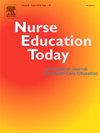Large-group simulation as a remote learning method in interprofessional health care education - a mixed methods study
IF 3.6
2区 医学
Q1 EDUCATION, SCIENTIFIC DISCIPLINES
引用次数: 0
Abstract
Background
Remote learning is expected to become more common in interprofessional health care education. Therefore, evidence-based knowledge about remote-learning methods is consistently needed to implement them more widely. Interprofessional large-group simulation is a suitable method for interprofessional education, but the knowledge on its remote implementation is scarce.
Aim
To describe the participants' experiences of the remotely implemented interprofessional large-group simulation and produce knowledge for further development.
Design
A convergent mixed methods study design was used.
Settings
A remotely implemented interprofessional large-group simulation in health care education was carried out in 2023.
Participants
Finnish interprofessional health care students and professionals from organizations at various educational levels and professional organizations (N = 810).
Methods
Data were collected via an online questionnaire from remote interprofessional large-group simulation participants (n = 263). Descriptive and multivariate methods as well as inductive content analysis were used in the data analysis.
Results
It emerged that the remotely implemented interprofessional large-group simulation was a suitable learning method for interprofessional collaboration competencies. According to the participants, the immersive structure of the large-group simulation promoted learning. The structure consisted of diverse pedagogical solutions, real-time and inspiring learning discussions, and user-oriented technical implementation in the large-group simulation. Professionals found the simulation a more activating learning method than students did.
Conclusions
The remotely implemented interprofessional large-group simulation proved to be a useful remote-learning method. Its immersive pedagogical implementation enabled the achievement of learning goals, but giving instructions for remote participation in advance proved important. Purposefully chosen technological solutions helped create a realistic, interactive, and psychologically pleasant learning environment. However, technological solutions to activate participants in remote learning need to be further developed.
背景远程学习有望在跨专业医疗保健教育中变得更加普遍。因此,为了更广泛地实施远程学习方法,我们始终需要有关远程学习方法的循证知识。目的描述参与者在远程实施跨专业大组模拟教学中的体验,并为进一步发展提供知识。设计采用聚合混合方法研究设计。方法通过在线问卷收集远程跨专业大组模拟参与者(n = 263)的数据。结果表明,远程实施的跨专业大组模拟是一种适合跨专业协作能力的学习方法。参与者认为,大组模拟的沉浸式结构促进了学习。这种结构包括多样化的教学方案、实时和启发式的学习讨论,以及在大组模拟中以用户为导向的技术实施。结论远程实施的跨专业大组模拟被证明是一种有用的远程学习方法。其身临其境的教学实施使学习目标得以实现,但事先为远程参与提供指导证明非常重要。有目的地选择技术解决方案有助于创造一个逼真、互动和心理愉悦的学习环境。不过,激活远程学习参与者的技术解决方案还需要进一步开发。
本文章由计算机程序翻译,如有差异,请以英文原文为准。
求助全文
约1分钟内获得全文
求助全文
来源期刊

Nurse Education Today
医学-护理
CiteScore
6.90
自引率
12.80%
发文量
349
审稿时长
58 days
期刊介绍:
Nurse Education Today is the leading international journal providing a forum for the publication of high quality original research, review and debate in the discussion of nursing, midwifery and interprofessional health care education, publishing papers which contribute to the advancement of educational theory and pedagogy that support the evidence-based practice for educationalists worldwide. The journal stimulates and values critical scholarly debate on issues that have strategic relevance for leaders of health care education.
The journal publishes the highest quality scholarly contributions reflecting the diversity of people, health and education systems worldwide, by publishing research that employs rigorous methodology as well as by publishing papers that highlight the theoretical underpinnings of education and systems globally. The journal will publish papers that show depth, rigour, originality and high standards of presentation, in particular, work that is original, analytical and constructively critical of both previous work and current initiatives.
Authors are invited to submit original research, systematic and scholarly reviews, and critical papers which will stimulate debate on research, policy, theory or philosophy of nursing and related health care education, and which will meet and develop the journal''s high academic and ethical standards.
 求助内容:
求助内容: 应助结果提醒方式:
应助结果提醒方式:


